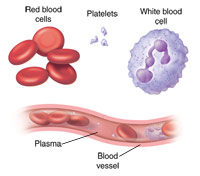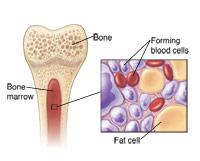What Are Red Blood Cells?
Red blood cells carry fresh oxygen all over the body. This is important to your health.

Red blood cells are round with a flattish, indented center, like doughnuts without a hole. Your healthcare provider can check on the size, shape, and health of your red blood cells using a blood test.
Red blood cells at work
Hemoglobin is the protein inside red blood cells. It carries oxygen. Red blood cells also remove carbon dioxide from your body, bringing it to the lungs for you to exhale.
Red blood cells are made in the bone marrow. They typically live for about 120 days, and then they die.

Nutrition and red blood cells
Foods rich in iron help you maintain healthy red blood cells. Vitamins are also needed to build healthy red blood cells. These include vitamins B-2, B-12, and B-3, found in foods, such as eggs, whole grains, and bananas. Folate also helps. It is found in fortified cereals, dried beans and lentils, orange juice, and green leafy vegetables.
Illnesses of the red blood cells
Most people don't think about their red blood cells unless they have a disease that affects these cells. Problems with red blood cells can be caused by illnesses or a lack of iron or vitamins in your diet. Some diseases of the red blood cells are inherited.
Diseases of the red blood cells include many types of anemia. This is a condition in which there are too few red blood cells to carry enough oxygen all over the body. People with anemia may have red blood cells that have an abnormal shape or that look normal, larger than normal, or smaller than normal.
Symptoms of anemia include tiredness, fast heart rate, pale skin, feeling cold, and, in severe cases, heart failure. Children who don't have enough healthy red blood cells grow and develop more slowly than other children. These symptoms show how important red blood cells are to your daily life.
These are common types of anemia:
-
Iron-deficiency anemia. If you don't have enough iron in your body, your body won't be able to make enough red blood cells. Iron-deficiency anemia is the most common form of anemia. Causes of iron deficiency include:
-
A diet low in iron
-
Sudden blood loss
-
Ongoing (chronic) blood loss, such as from heavy menstrual periods
-
Inability to absorb enough iron from food, such as from weight-loss surgery
-
Sickle cell anemia. In this inherited disease, the red blood cells are shaped like half-moons rather than the normal indented circles. This change in shape can make the cells "sticky" and unable to flow smoothly through blood vessels. This causes a blockage in blood flow. This may cause sudden (acute) or chronic pain. It can also lead to infection or organ damage. Sickle cells die much more quickly than normal blood cells—in about 10 to 20 days instead of 120 days. This causes a shortage of red blood cells.
-
Normocytic anemia. With this type of anemia your red blood cells are a normal shape and size. But you don't have enough of them to meet your body's needs. Diseases that cause this type of anemia are often long-term conditions, such as kidney disease, cancer, or rheumatoid arthritis.
-
Hemolytic anemia. This type of anemia happens when red blood cells are destroyed by an abnormal process in your body before their lifespan is over. As a result, your body doesn't have enough red blood cells to function. And your bone marrow can't make enough to keep up with demand.
-
Fanconi anemia. This is a rare inherited disorder in which your bone marrow isn't able to make enough of any of the components of blood, including red blood cells. Children born with this disorder often have serious birth defects because of the problems with their blood. They may develop leukemia.